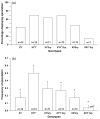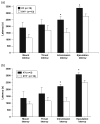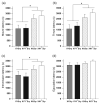Effects of sex chromosome aneuploidy on male sexual behavior
- PMID: 18363850
- PMCID: PMC2563427
- DOI: 10.1111/j.1601-183X.2008.00397.x
Effects of sex chromosome aneuploidy on male sexual behavior
Abstract
Incidence of sex chromosome aneuploidy in men is as high as 1:500. The predominant conditions are an additional Y chromosome (47,XYY) or an additional X chromosome (47,XXY). Behavioral studies using animal models of these conditions are rare. To assess the role of sex chromosome aneuploidy on sexual behavior, we used mice with a spontaneous mutation on the Y chromosome in which the testis-determining gene Sry is deleted (referred to as Y(-)) and insertion of a Sry transgene on an autosome. Dams were aneuploid (XXY(-)) and the sires had an inserted Sry transgene (XYSry). Litters contained six male genotypes, XY, XYY(-), XXSry, XXY(-)Sry, XYSry and XYY(-)Sry. In order to eliminate possible differences in levels of testosterone, all of the subjects were castrated and received testosterone implants prior to tests for male sex behavior. Mice with an additional copy of the Y(-) chromosome (XYY(-)) had shorter latencies to intromit and achieve ejaculations than XY males. In a comparison of the four genotypes bearing the Sry transgene, males with two copies of the X chromosome (XXSry and XXY(-)Sry) had longer latencies to mount and thrust than males with only one copy of the X chromosome (XYSry and XYY(-)Sry) and decreased frequencies of mounts and intromissions as compared with XYSry males. The results implicate novel roles for sex chromosome genes in sexual behaviors.
Figures





References
-
- Boone KB, Swerdloff RS, Miller BL, Geschwind DH, Razani J, Lee A, Gonzalo IG, Haddal A, Rankin K, Lu P, Paul L. Neuropsychological profiles of adults with Klinefelter syndrome. J Int Neuropsychol Soc. 2001;7:446–456. - PubMed
-
- Brown WA, Monti PM, Corriveau DP. Serum testosterone and sexual activity and interest in men. Arch Sex Behav. 1978;7:97–103. - PubMed
-
- Burgoyne PS, Lovell-Badge R, Rattigan A. Evidence that the testis determination pathway interacts with a non-dosage compensated. X-linked gene Int J Dev Biol. 2001;45:509–512. - PubMed
-
- Burns-Cusato M, Scordalakes EM, Rissman EF. Of mice and missing data: what we know (and need to learn) about male sexual behavior. Physiol Behav. 2004;83:217–232. - PubMed
-
- Clemens LG, Wee BE, Weaver DR, Roy EJ, Goldman BD, Rakerd B. Retention of masculine sexual behavior following castration in male B6D2F1 mice. Physiol Behav. 1988;42:69–76. - PubMed
Publication types
MeSH terms
Substances
Grants and funding
LinkOut - more resources
Full Text Sources
Molecular Biology Databases

